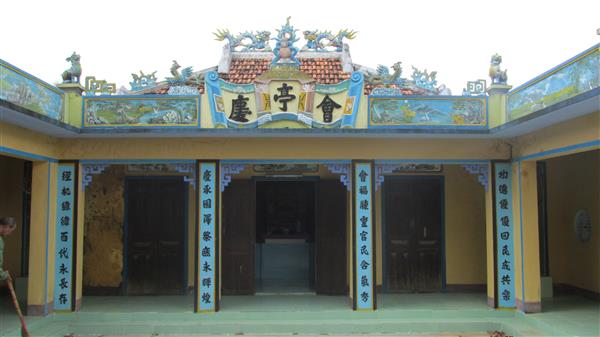Description
Hoi Khanh communal house is located on Nguyen Hue street, in Hoi Khanh village, Van Khanh commune, Van Ninh district, Khanh Hoa province (formerly Hoi Toan village, belonging to Ha canton, Quang Phuoc district, Binh Hoa province)[1]. The communal house is about 12km north of Van Gia town.
Through studying the historical documents of Hoi Khanh communal house, there is not a single document mentioning the time of construction of the communal house, so it is only possible to rely on the documents of the ordination of the communal house to determine the exact date. relative. The earliest date is Thanh Thai in the 2nd year (1890), which can confirm that Hoi Khanh communal house was built before 1890. The communal house was originally made of simple, thatch, bamboo, leaves. to worship the Imperial City and other gods.
Over time, with the influence of the weather and the destruction of the war, the communal house has been degraded, the people have contributed and contributed many times to restore the communal house:
- First renovation: In 1889, Hoi Khanh communal house was severely damaged due to frequent bombardment by the French colonialists (because this place used to be the commanding place of the Can Vuong movement against the French colonialists: Nguyen Sum , Pham Chanh, Pham Long), people have contributed to the restoration of the monument (the wooden frame in the main hall) is preserved;
- Second renovation: During the years of resistance against the French colonialists (1946-1954), Hoi Khanh communal house was used as a warehouse for food and supplies for soldiers, so the relic was a target for bombardment. of the enemy, causing damage to many items and works. In 1956, the communal house was seriously degraded, people continued to repair it (this renovation is mainly the main hall).
- The third renovation: In 1972, Hoi Khanh communal house overhauled the following items: the main hall, the east house, the west house, the Thien Y temple, the Thanh Minh temple, and the feng shui.

 The main hall of Hoi Khanh
The main hall of Hoi Khanh
The relic is located on a flat land, beautiful terrain in the middle of the village, with open space, with an area of 1,361m2, the communal house faces Southeast. The communal house has an overall layout as follows: An Phong, Thien Y Temple and Tieu Dai Dai Dai Dai Temple, the main hall, the east house, and the west house.


The altar of worship at Hoi Khanh communal house according to the northern customs and practices
Hoi Khanh communal house is a place to keep many relics and antiquities of tangible and intangible value: Han documents, Nom, worship, gongs, drums, mules, rituals, worship rituals, literature, ritual music. , traditional costume singing boi. In particular, the relic still preserves three ordinations bestowed by the Nguyen kings, including:
- Ordaining Khai Dinh in the 2nd year (1890) conferred on Ban Canh Thanh Hoang;
- Ordaining Duy Tan in the 3rd year (1909) conferred on Ban Canh Thanh Hoang;
- Ordaining Khai Dinh in the 9th year (1924) conferred on Ban Canh Thanh Hoang.
In particular, the annual traditional festival is held in the third and eighth lunar month.
In addition to its outstanding architectural and artistic value, the monument also preserves many local historical events during the resistance war against the French colonialists. During the Can Vuong movement, this place used to be the commanding place of Mr. Nguyen Sum, Pham Chanh, Pham Long (named "Quang Phuoc tam Hung" by the people) who led the anti-French colonial movement.
Hoi Khanh communal house has common characteristics with other communal houses around the region, the relic was created by residents of the northern provinces following the Nguyen Lords to settle down, they brought with them customs and habits, including the custom of worshiping the ancestors. Gods in communal houses, shrines, mausoleums... to create faith in life, there are still many difficulties in the new settlement. Over several centuries of existence, the relic is both a place to preserve cultural practices, traditional rituals and beliefs, and a place for community cultural activities. Not only that, the relic is also a place to preserve many typical values of traditional local art and architecture, which are reflected in the work items that have existed in the relic for hundreds of years. Because of the typical values on the relic, the People's Committee of Khanh Hoa province issued Decision No. 1891/QD-UBND, dated November 6, 2006 classified as a provincial historical - cultural relic.
[1] Translated by Nguyen Dinh Dau, (1997), Research on the Nguyen Khanh Hoa dynasty, Ho Chi Minh City Publishing House.